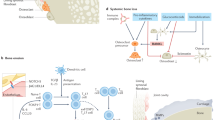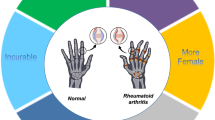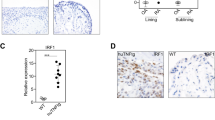Abstract
Studies on the pathogenesis of inflammatory arthritides have begun to delve into the molecular and cellular mechanisms behind the development of these diseases, and transcription factors, as key regulators of immune-effector-cell development and function, have received growing attention. Their involvement in immune cells, such as T and B lymphocytes, macrophages and neutrophils, and cells from diseased tissues, such as synoviocytes, has been investigated, revealing dominant roles for members of the nuclear factor κB family, signal-transducer and activator of transcription family, and activator protein 1 family. This review summarizes recent findings and current knowledge regarding the roles of transcription factors in inflammatory arthritis, as evidenced by both biological and genetic studies, and discusses the relevance of these findings for anti-inflammatory therapies.
Key Points
-
Key roles have been identified in the pathogenesis of inflammatory arthritis for transcription factors, particularly members of the nuclear factor κB family, signal transducer and activator of transcription family, and activator protein 1 family
-
Additional transcription factors, such as interferon regulatory factor and nuclear factor of activated T cell family members, probably contribute to disease pathogenesis
-
Genetic studies have revealed associations between rheumatoid arthritis and polymorphisms in transcription factor binding sites and/or genes that regulate transcription factor activity
-
Effective therapies for inflammatory arthritis inhibit transcription factors known to have key roles in the pathogenesis of arthritis, including nuclear factor κB and activator protein 1
-
Novel therapies in arthritis are likely to continue to affect well-established transcription factors, but will probably target additional transcription factor pathways as well, such as signal-transducer and activator of transcription or Forkhead
This is a preview of subscription content, access via your institution
Access options
Subscribe to this journal
Receive 12 print issues and online access
$209.00 per year
only $17.42 per issue
Buy this article
- Purchase on Springer Link
- Instant access to full article PDF
Prices may be subject to local taxes which are calculated during checkout

Similar content being viewed by others
References
Sweeney SE and Firestein GS (2004) Signal transduction in rheumatoid arthritis. Curr Opin Rheumatol 16: 231–237
Wakeland EK et al. (2001) Delineating the genetic basis of systemic lupus erythematosus. Immunity 15: 397–408
Li Q and Verma IM (2002) NF-kB regulation in the immune system.[erratum appears in Nat Rev Immunol 2002 Dec;2(12):975]. Nature Rev Immunol Immunology 2: 725–734
Peng SL (2004) Transcription factors in the pathogenesis of autoimmunity. Clin Immunol 110: 112–123
Granet C et al. (2004) Increased AP-1 and NF-kB activation and recruitment with the combination of the proinflammatory cytokines IL-1b, tumor necrosis factor a and IL-17 in rheumatoid synoviocytes. Arthritis Res Ther 6: R190–198
Hwang SY et al. (2004) IL-17 induces production of IL-6 and IL-8 in rheumatoid arthritis synovial fibroblasts via NF-kB- and PI3-kinase/Akt-dependent pathways. Arthritis Res Ther 6: R120–128
Foell D et al. (2003) Expression of the pro-inflammatory protein S100A12 (EN-RAGE) in rheumatoid and psoriatic arthritis. Rheumatology 42: 1383–1389
Pullerits R et al. (2003) High mobility group box chromosomal protein 1, a DNA binding cytokine, induces arthritis. Arthritis Rheum 48: 1693–1700
Bai S et al. (2004) NF-kB-regulated expression of cellular FLIP protects rheumatoid arthritis synovial fibroblasts from tumor necrosis factor a-mediated apoptosis. Arthritis Rheum 50: 3844–3855
Dai S et al. (2004) The IkB kinase (IKK) inhibitor, NEMO-binding domain peptide, blocks osteoclastogenesis and bone erosion in inflammatory arthritis. J Biol Chem 279: 37219–37222
Aya K et al. (2005) NF-kB-inducing kinase controls lymphocyte and osteoclast activities in inflammatory arthritis. J Clin Invest 115: 1848–1854
Benito MJ et al. (2004) Increased synovial tissue NF-k1 expression at sites adjacent to the cartilage-pannus junction in rheumatoid arthritis. Arthritis Rheum 50: 1781–1787
Nakashima T et al. (2003) RANKL and RANK as novel therapeutic targets for arthritis. Curr Opin Rheumatol 15: 280–287
Clohisy, J.C. et al. (2003) Direct inhibition of NF-kB blocks bone erosion associated with inflammatory arthritis. J Immunol 171: 5547–5553
O'Shea JJ et al. (2002) Cytokine signaling in 2002: new surprises in the Jak/Stat pathway. Cell 109 (Suppl): S121–S131
Huckel M et al. (2006) Attenuation of murine antigen-induced arthritis by treatment with a decoy oligodeoxynucleotide inhibiting signal transducer and activator of transcription-1 (STAT-1). Arthritis Res Ther 8: R17
Shouda T et al. (2001) Induction of the cytokine signal regulator SOCS3/CIS3 as a therapeutic strategy for treating inflammatory arthritis. J Clin Invest 108: 1781–1788
Hirayama T et al. (2005) Inhibition of inflammatory bone erosion by constitutively active STAT-6 through blockade of JNK and NF-kB activation. Arthritis Rheum 52 2719–2729
Shaulian E and Karin M (2002) AP-1 as a regulator of cell life and death. Nat Cell Biol 4: E131–E136
Shiozawa S et al. (1997) Studies on the contribution of c-fos/AP-1 to arthritic joint destruction. J Clin Invest 99: 1210–1216
Boyce BF et al. (2005) Roles for NF-kB and c-Fos in osteoclasts. J Bone Miner Metab 23: 11–15
Juarranz Y et al. (2005) Protective effect of vasoactive intestinal peptide on bone destruction in the collagen-induced arthritis model of rheumatoid arthritis. Arthritis Res Ther 7: R1034–R1045
Macian F (2005) NFAT proteins: key regulators of T-cell development and function. Nature Rev Immunol 5: 472–484
Langford CA et al. (1998) Use of cytotoxic agents and cyclosporine in the treatment of autoimmune disease. Part 1: rheumatologic and renal diseases. Ann Intern Med 128: 1021–1028
Gerth AJ et al. (2004) Regulation of the symmetry and intensity of immune complex-mediated synovitis by nuclear factor of activated T cells. Arthritis Rheum 50: 3392–3395
Takayanagi H et al. (2002) Induction and activation of the transcription factor NFATc1 (NFAT2) integrate RANKL signaling in terminal differentiation of osteoclasts. Dev Cell 3: 889–901
Urushibara M et al. (2004) The antirheumatic drug leflunomide inhibits osteoclastogenesis by interfering with receptor activator of NF-kB ligand-stimulated induction of nuclear factor of activated T cells c1. Arthritis Rheum 50: 794–804
Taniguchi T et al. (2001) IRF family of transcription factors as regulators of host defense. Ann Rev Immunol 19: 623–655
Shiraishi A et al. (1997) The role of IFN regulatory factor-1 in synovitis and nitric oxide production. J Immunol 159: 3549–3554
Tada Y et al. (1997) Reduced incidence and severity of antigen-induced autoimmune diseases in mice lacking interferon regulatory factor-1. J Exp Med 185: 231–238
Jonsson H and Peng SL (2005) Forkhead transcription factors in immunology. Cell Mol Life Sci 62, 397–409
Hori S et al. (2003) Control of regulatory T cell development by the transcription factor Foxp3. Science 299: 1057–1061
Jonsson H et al. (2005) Inflammatory arthritis requires Foxo3a to prevent Fas ligand-induced neutrophil apoptosis. Nat Med 11: 666–671
Szabo SJ et al. (2003) Molecular mechanisms regulating Th1 immune responses. Ann Rev Immunol 21: 713–758
Kawashima M and Miossec P (2005) mRNA quantification of T-bet, GATA-3, IFN-g, and IL-4 shows a defective Th1 immune response in the peripheral blood from rheumatoid arthritis patients: link with disease activity. J Clin Immunol 25: 209–214
Wang J et al. (2006) Transcription factor T-bet regulates inflammatory arthritis through its function in dendritic cells. J Clin Invest 116: 414–421
Tokuhiro S et al. (2003) An intronic SNP in a RUNX1 binding site of SLC22A4, encoding an organic cation transporter, is associated with rheumatoid arthritis. Nat Genet 35: 341–348
Till A et al. (2005) The Met-196 -> Arg variation of human tumor necrosis factor receptor 2 (TNFR2) affects TNF-a-induced apoptosis by impaired NF-kB signaling and target gene expression. J Biol Chem 280: 5994–6004
Latchman DS (2000) Transcription factors as potential targets for therapeutic drugs. Curr Pharm Biotechnol 1: 57–61
Auphan N et al. (1995) Immunosuppression by glucocorticoids: inhibition of NF-kB activity through induction of IkB synthesis. Science 270: 286–290
Scheinman RI et al. (1995) Role of transcriptional activation of IkBa in mediation of immunosuppression by glucocorticoids. Science 270: 283–286
Wahl C et al. (1998) Sulfasalazine: a potent and specific inhibitor of nuclear factor kB. J Clin Invest 101: 1163–1174
Yin MJ et al. (1998) The anti-inflammatory agents aspirin and salicylate inhibit the activity of IkB kinase-b. Nature 396: 77–80
Manna SK and Aggarwal BB (1999) Immunosuppressive leflunomide metabolite (A77 1726) blocks TNF-dependent nuclear factor-kB activation and gene expression. J Immunol 162: 2095–2102
Bonizzi G et al. (1997) Distinct signal transduction pathways mediate nuclear factor-kB induction by IL-1b in epithelial and lymphoid cells. J Immunol 159: 5264–5272
Edmead CE et al. (1996) Induction of activator protein (AP)-1 and nuclear factor-kB by CD28 stimulation involves both phosphatidylinositol 3-kinase and acidic sphingomyelinase signals. J Immunol 157: 3290–3297
Ivery MT (2000) Immunophilins: switched on protein binding domains? Med Res Rev 20: 452–484
Kodama S et al. (2005) The therapeutic potential of tumor necrosis factor for autoimmune disease: a mechanistically based hypothesis. Cell Mol Life Sci 62: 1850–1862
Dempsey PW et al. (2003) The signaling adaptors and pathways activated by TNF superfamily. Cytokine Growth Factor Rev 14: 193–209
Li X and Qin J (2005) Modulation of Toll-interleukin 1 receptor mediated signaling. J Mol Med 83: 258–266
Fraser JH et al. (1999) CTLA4 ligation attenuates AP-1, NFAT and NF-kB activity in activated T cells. Eur J Immunol 29: 838–844
Fallarino F et al. (2004) CTLA-4-Ig activates forkhead transcription factors and protects dendritic cells from oxidative stress in nonobese diabetic mice. J Exp Med 200: 1051–1062
Pandiyan P et al. (2004) CD152 (CTLA-4) determines the unequal resistance of Th1 and Th2 cells against activation-induced cell death by a mechanism requiring PI3 kinase function. J Exp Med 199: 831–842
Podojil JR et al. (2004) CD86 and b2-adrenergic receptor signaling pathways, respectively, increase Oct-2 and OCA-B Expression and binding to the 3′-IgH enhancer in B cells. J Biol Chem 279: 23394–23404
Ehrenstein MR et al. (2004) Compromised function of regulatory T cells in rheumatoid arthritis and reversal by anti-TNFa therapy. J Exp Med 200: 277–285
Okazaki Y et al. (2005) Effect of nuclear factor-kB inhibition on rheumatoid fibroblast-like synoviocytes and collagen induced arthritis. J Rheumatol 32: 1440–1447
Kiani A et al. (2000) Manipulating immune responses with immunosuppressive agents that target NFAT. Immunity 12: 359–372
Morishita R et al. (2004) Molecular therapy to inhibit NFkB activation by transcription factor decoy oligonucleotides. Curr Opin Pharmacol 4: 139–146
Muller P et al. (2005) Identification of JAK/STAT signalling components by genome-wide RNA interference. Nature 436: 871–875
Acknowledgements
We thank Christina Pioppi for assistance with literature review, as well as the authors of the many primary manuscripts which formed the basis of this review but were unable to be cited here for space considerations.
Author information
Authors and Affiliations
Corresponding author
Ethics declarations
Competing interests
The authors declare no competing financial interests.
Rights and permissions
About this article
Cite this article
Aud, D., Peng, S. Mechanisms of Disease: transcription factors in inflammatory arthritis. Nat Rev Rheumatol 2, 434–442 (2006). https://doi.org/10.1038/ncprheum0222
Received:
Accepted:
Issue Date:
DOI: https://doi.org/10.1038/ncprheum0222
This article is cited by
-
Role of S100A12/RAGE axis in eccentric exercise-induced delayed-onset muscle soreness in male non-athletes
Sport Sciences for Health (2015)
-
Foxo in the immune system
Oncogene (2008)
-
Decoy oligodeoxynucleotide targeting activator protein-1 (AP-1) attenuates intestinal inflammation in murine experimental colitis
Laboratory Investigation (2008)



